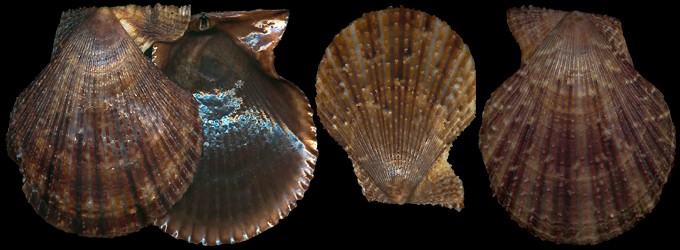COLOUR & PATTERN VARIATIONS


These patterns are similar to those of the young A. opercularis which live in the same area.

Left: a subadult (42mm) progressively lacking its juvenile pattern.
Right: transition to white shells with 3 young adult specimens (49mm, 52mm, 47mm).
It often happens that concentric "rings" appear of both valves, as seen on the two shells at the middle of the picture above. They may represent an abrupt change in the energy industry of the animal. I believe these changes can be classified in two categories:
1- At the transition between the juvenile-mobile stage and the adult-sedentary stage:
as many Pectinidae, the young varia can crawl on their support, and fix them temporarily. While growing, they lose this capacity to produce byssal threads on demand, and are fixed definitively.
2- Each winter, each spring impose a particular diet. This reason is most obvious, and does not certainly deserve any additional line. But we can notice that, on this occasion, the changes are not only chromatic, but relate also to the thickness of the shell, as in Muricidae, Conidae etc. etc. etc.
Right: transition to white shells with 3 young adult specimens (49mm, 52mm, 47mm).
It often happens that concentric "rings" appear of both valves, as seen on the two shells at the middle of the picture above. They may represent an abrupt change in the energy industry of the animal. I believe these changes can be classified in two categories:
1- At the transition between the juvenile-mobile stage and the adult-sedentary stage:
as many Pectinidae, the young varia can crawl on their support, and fix them temporarily. While growing, they lose this capacity to produce byssal threads on demand, and are fixed definitively.
2- Each winter, each spring impose a particular diet. This reason is most obvious, and does not certainly deserve any additional line. But we can notice that, on this occasion, the changes are not only chromatic, but relate also to the thickness of the shell, as in Muricidae, Conidae etc. etc. etc.

The rings are often more apparent on pale shells. On the right one, a dark ring begins just before a change in thickness. Could it mean that a diet change occured some weeks before a growth acceleration?
Young adult shells: 48mm & 50mm.
Young adult shells: 48mm & 50mm.